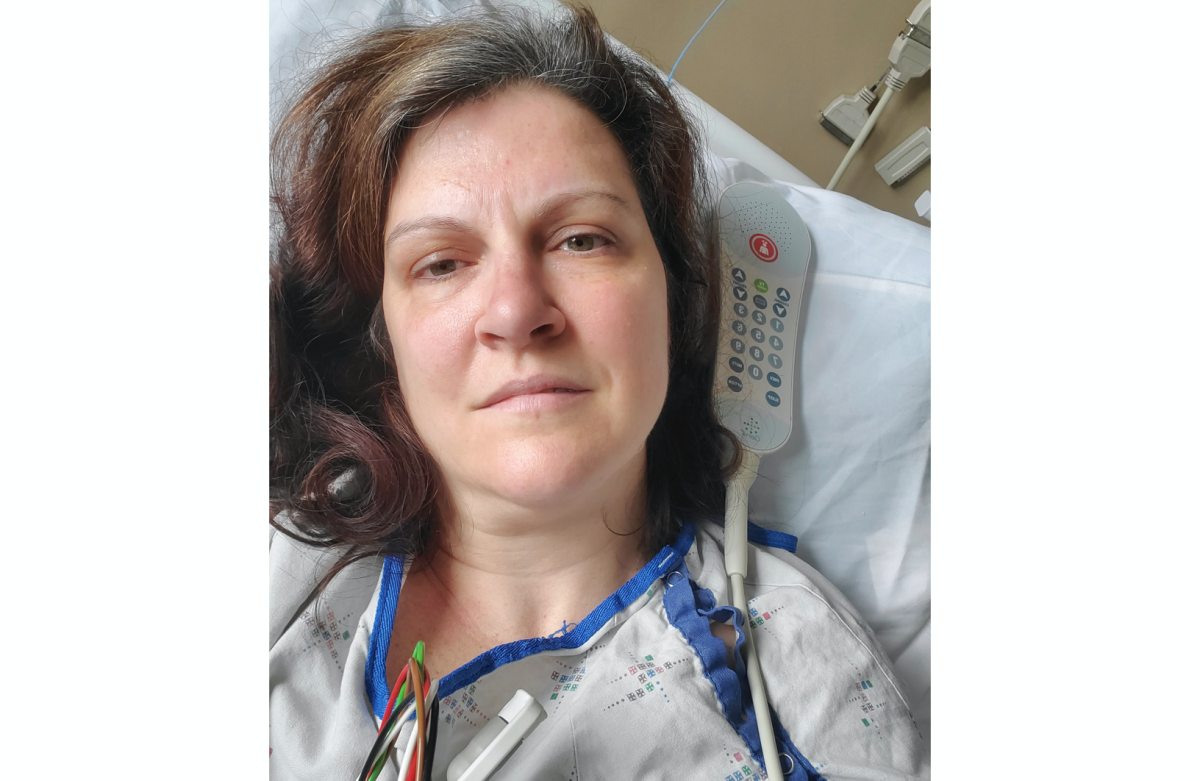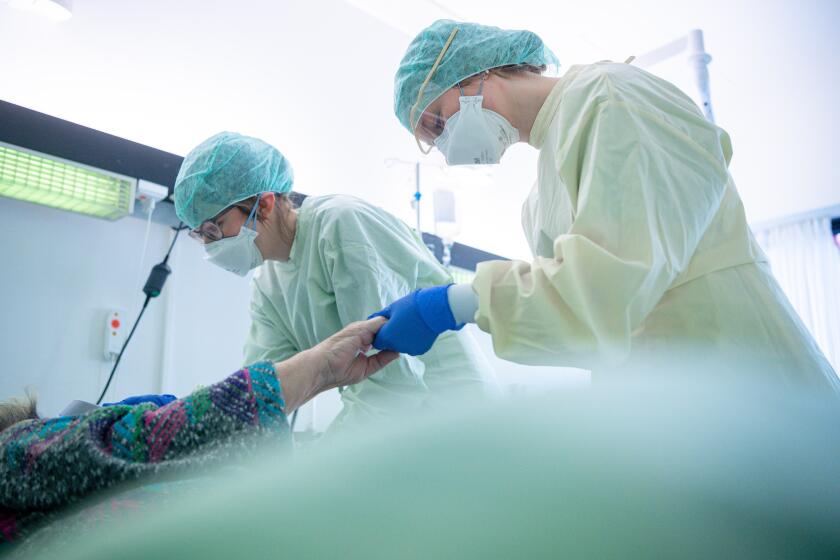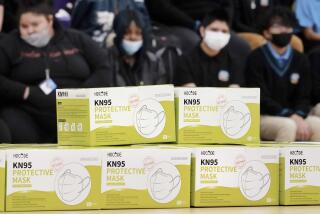Dangerous blood clots pose a perplexing coronavirus threat

First came a high fever, drenching sweats and muscle aches. Then, almost a month later, a weird numbness that spread down the right side of her body.
Darlene Gildersleeve of Hopkinton, N.H., thought she had recovered from COVID-19. Doctors said the 43-year-old mother of three just needed rest. And for several days, no one suspected her worsening symptoms were related — until a May 4 video call, when her physician heard her slurred speech and consulted a specialist.
“You’ve had two strokes,’’ a neurologist told her at the hospital.
Blood clots that can cause strokes, heart attacks and dangerous blockages in the legs and lungs are increasingly being found in COVID-19 patients, including some children. Even tiny clots that can damage tissue throughout the body have been seen in hospitalized patients and in autopsies, confounding doctors’ understanding of what was once considered mainly a respiratory disease.
“I have to be humble and say I don’t know what’s going on there, but, boy, we need to find that out,” Dr. Anthony Fauci, the nation’s top infectious disease expert, remarked during an interview with a medical journal last month. Unless doctors know what’s causing a patient’s symptoms, “it’s going to be tough to do intervention,” he said.
Gildersleeve said health authorities “need to put out an urgent warning about strokes” and coronavirus infection. Not knowing the possible link “made me doubt myself” when symptoms appeared, she said.
Some conditions that make some COVID-19 patients vulnerable to severe complications, including obesity and diabetes, can increase clot risks. But many authorities believe how the virus attacks and the way the body responds both play a role.
“COVID-19 is the most thrombotic [clot-producing] disease we’ve ever seen in our lifetime,” said Dr. Alex Spyropoulos, a clot specialist and professor at Feinstein Institutes for Medical Research in Manhasset, N.Y.
Clotting has been seen in other coronavirus infections, including SARS, but on a much smaller scale, he said.
Scientists think the coronavirus enters the body through enzyme receptors found throughout the body, including in cells lining the inside of blood vessels. Some theorize that it may promote clotting by somehow injuring those vessels as it spreads. That injury may cause a severe immune response as the body tries to fight the infection, resulting in inflammation that may also damage vessels and promote clotting, said Dr. Valentin Fuster, director of Mount Sinai Heart hospital in New York.
It’s unclear how many COVID-19 patients develop clots. Studies from China, Europe and the United States suggest rates ranging from 3% to 70% of hospitalized COVID-19 patients. More rigorous research is needed to determine the true prevalence, the National Institutes of Health says.
Doctors caring for the sickest COVID-19 patients are trying new ways to attack the coronavirus. One theory is that they have blood clots in their lungs.
Prevalence in patients with mild disease is unknown. The NIH says there isn’t enough evidence to recommend routine clot screening for all COVID-19 patients without clotting symptoms, which may include swelling, pain or reddish discoloring in an arm or leg.
Some hospitals have found that 40% of COVID-19 patient deaths are due to blood clots. Spyropoulos said that’s been true at his 23-hospital system in the New York City area, Northwell Health, which has treated over 11,000 COVID-19 patients.
Patients hospitalized with any severe illness face increased risks for clots, partly from being bedridden and inactive, and they commonly receive blood-thinning drugs for prevention. Some doctors are trying higher-than-usual doses for prevention in hospitalized COVID-19 patients.
A few have used powerful clot-busting medicines typically prescribed to treat strokes, with mixed results. In guidance issued May 12, the NIH said more research is needed to show whether that approach has any benefits.
Fuster was involved in preliminary research on nearly 2,800 COVID-19 patients at five hospitals in the Mount Sinai system. Among those who were on ventilators, patients who received blood thinners seemed to have slightly better survival chances than those who didn’t. Although the results are not conclusive, all COVID-19 patients at Mount Sinai receive blood thinners for clot prevention unless they are at risk for bleeding, a potential side effect, Fuster said.
Some COVID-19 patients, like Gildersleeve, develop dangerous clots when their infections seem to have subsided, Spyropoulos said. Patients treated at Northwell for severe disease are sent home with a once-a-day blood thinner, and a forthcoming study will detail their experiences. (Spyropoulos has been a paid consultant to Janssen Pharmaceuticals, which makes the blood thinner.)
Some patients who have recovered from coronavirus infection are suffering lasting damage, including liver damage, heart damage and blood clotting problems.
In addition, Northwell is taking part in a multi-center study that will test blood thinners for clot prevention in COVID-19 patients who aren’t sick enough to require hospitalization.
Concerns about blood clots in COVID-19 patients prompted a recent 30-page consensus statement from an international group of physicians and researchers. It says that X-rays, ultrasound exams and other tests could be used to find clots that require treatment, but those procedures pose a risk for healthcare workers because the virus is so contagious.
Social distancing may make people more sedentary and more vulnerable to clots, particularly older adults, so doctors should encourage activity or exercises that can be done in the home as a preventive measure, the statement says.
Warnell Vega got that advice after collapsing at home April 19 from a large clot blocking a lung artery. Doctors at Mount Sinai Morningside think it was coronavirus-related. Vega, 33, a lunch maker for New York City school children, spent a week in intensive care on oxygen and blood thinners, which he’s been told to continue taking for three months.
“I just have to watch out for any bleeding, and have to be careful not to cut myself,” Vega said.
Gildersleeve, the New Hampshire stroke patient, was also sent home with a blood thinner. She gets physical therapy to improve strength and balance. She still has some numbness and vision problems that mean driving is out, for now.
Doctors are unable to predict when or whether she’ll regain all her abilities.
’’I’m trying to remain positive about recovering,” she said. ’’I just have to be patient and listen to my body and not push too hard.”








